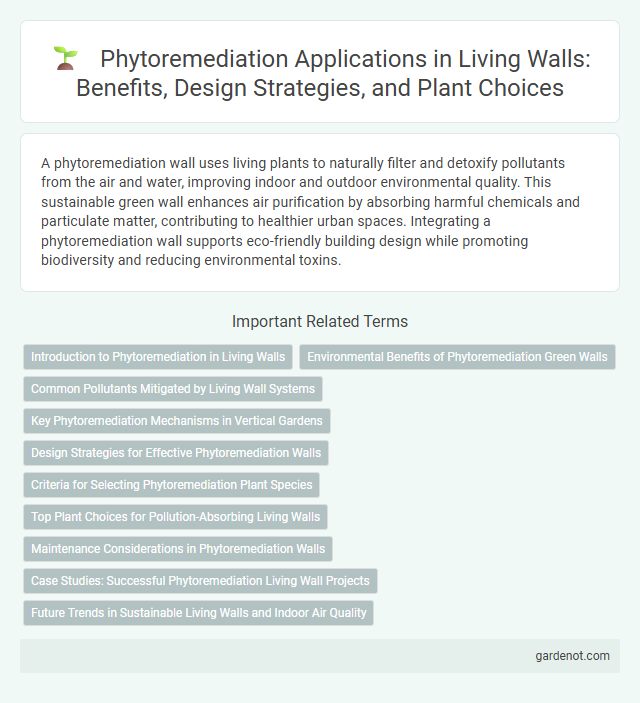A phytoremediation wall uses living plants to naturally filter and detoxify pollutants from the air and water, improving indoor and outdoor environmental quality. This sustainable green wall enhances air purification by absorbing harmful chemicals and particulate matter, contributing to healthier urban spaces. Integrating a phytoremediation wall supports eco-friendly building design while promoting biodiversity and reducing environmental toxins.
Introduction to Phytoremediation in Living Walls
Phytoremediation walls utilize specialized plants to absorb, filter, and break down environmental pollutants, enhancing air and water quality in urban spaces. These living walls incorporate species with high pollutant uptake capacity, such as spider plants and peace lilies, optimizing the detoxification process. Integrating phytoremediation into vertical gardening offers sustainable solutions for improving urban ecosystems and reducing airborne toxins.
Environmental Benefits of Phytoremediation Green Walls
Phytoremediation green walls utilize specific plants to absorb, degrade, or immobilize pollutants from air and soil, significantly improving urban air quality and reducing toxic substances. These living walls enhance biodiversity by providing habitats for beneficial microorganisms and insects, contributing to ecosystem restoration. Their capacity to filter volatile organic compounds (VOCs) and heavy metals supports sustainable environmental management and promotes healthier urban living spaces.
Common Pollutants Mitigated by Living Wall Systems
Living wall systems utilizing phytoremediation effectively reduce indoor air pollutants such as formaldehyde, benzene, and nitrogen dioxide by absorbing and metabolizing these harmful compounds through plant leaves and root-associated microbes. Studies show species like pothos (Epipremnum aureum) and spider plants (Chlorophytum comosum) excel in mitigating volatile organic compounds (VOCs), enhancing air quality in urban environments. This natural filtration reduces airborne toxins, contributing to healthier indoor ecosystems and improved occupant well-being.
Key Phytoremediation Mechanisms in Vertical Gardens
Phytoremediation walls leverage key mechanisms such as phytoextraction, phytodegradation, and phytostabilization to effectively cleanse air and soil pollutants in vertical gardens. These living systems use plant roots and associated microorganisms to absorb, break down, or immobilize contaminants like heavy metals, volatile organic compounds, and particulate matter. Integrating species with high remediation capacity enhances urban air quality and supports sustainable environmental management through innovative green infrastructure.
Design Strategies for Effective Phytoremediation Walls
Effective phytoremediation wall design incorporates selecting plant species with high tolerance to local pollutants and robust root systems for soil stabilization. Integrating modular panels with substrate layers optimized for contaminant absorption enhances pollutant uptake efficiency. Incorporating irrigation systems ensures optimal moisture levels, promoting sustained plant growth and maximizing contaminant removal.
Criteria for Selecting Phytoremediation Plant Species
Selecting phytoremediation plant species for living walls requires prioritizing traits such as high pollutant uptake capacity, rapid growth rate, and adaptability to vertical environments. Species with deep root systems and tolerance to local climatic conditions improve contaminant absorption and overall system efficiency. Additionally, selecting plants with low maintenance needs and resistance to pests ensures sustainable, long-term air and water purification benefits.
Top Plant Choices for Pollution-Absorbing Living Walls
Spider plants, Boston ferns, and peace lilies excel at removing airborne toxins like formaldehyde, benzene, and carbon monoxide, making them ideal for phytoremediation walls. English ivy and snake plants effectively absorb pollutants while thriving in low-light environments, enhancing indoor air quality. Combining these species creates a highly efficient living wall that maximizes pollutant absorption and supports sustainable urban environments.
Maintenance Considerations in Phytoremediation Walls
Phytoremediation walls require consistent monitoring of soil moisture and nutrient levels to ensure optimal plant health and contaminant absorption. Regular pruning and removal of senescent foliage prevent clogging and maintain efficient airflow and light penetration. Implementation of integrated pest management and periodic substrate replacement are critical to sustaining the long-term effectiveness of phytoremediation systems.
Case Studies: Successful Phytoremediation Living Wall Projects
Phytoremediation living walls have demonstrated significant success in urban environments by effectively reducing air pollutants and improving indoor air quality, as evidenced in projects like the CaixaForum Museum in Madrid and the Athenaeum in London. These case studies highlight how species such as spider plants, English ivy, and pothos effectively absorb volatile organic compounds (VOCs) and particulate matter, enhancing environmental health. Implementation of phytoremediation walls not only supports sustainable building design but also contributes to urban biodiversity and ecological resilience.
Future Trends in Sustainable Living Walls and Indoor Air Quality
Phytoremediation walls use specific plant species to absorb and break down indoor air pollutants, significantly improving air quality in urban environments. Future trends in sustainable living walls emphasize integrating advanced biofiltration systems and smart sensors for real-time monitoring of air purification efficiency. Innovations in plant selection and wall design aim to maximize toxin absorption while maintaining aesthetic appeal and energy efficiency in indoor spaces.
Phytoremediation wall Infographic

 gardenot.com
gardenot.com